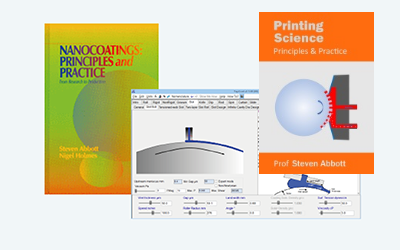Viscosity
Quick Start
We have three apps relating to viscosity.
- Calculating the viscosity of a mixture
- Calculating the change of viscosity with polymer concentration
- Calculating how viscosity depends on emulsion or particle concentration
Explore whichever ones interest you!
Viscosity Mix
The first topic is the apparently simple question of what happens if you mix two solutions of different dynamic viscosities η. There are two methods, neither of which has much backing, based on the kinematic viscosities `ν=η/ρ`. The first is the Refutas equation. The procedure is to calculate Viscosity Blending Numbers, VBN, for each component, then create a VBN for the mix based on the mass fractions, xi, then convert the mix VBN back to viscosity.
`VBN_i = 14.534.ln(ln(η+0.8))+10.975`
`VBN_(mix) = x_1.VBN_1 + x_2.VBN_2`
`ν_R = exp(exp((VBN_( mix)-10.975)/14.534))-0.8`
The second method is Kendall-Munroe.
`ν_R^(1/3) = x_1ν_1^(1/3) + x_2ν_2^(1/3)`
Given that the predicted values can differ greatly, it is hard to know what to do with these values. Just pick whichever seems to work for you.
Up to May 2022 the app used only dynamic viscosities till my error was pointed out Michał Kawa and the app updated.
Viscosity dependence on polymer concentration
Concentration Dependence
Next we need to know what sorts of things happen when we change the concentration of a polymer in our coating/printing solution. The approach here is comparatively user friendly. A more sophisticated version is in Polymer Viscosity app in Practical Solubility.
The complicated behaviour is simplified in the app. You have the viscosity of the base solvent. You then set a concentration, CE at which the polymer chains become fully entangled - at this point the viscosity increases rapidly. You select a concentration range of interest. Finally, you need to provide Rg, the radius of gyration of your polymer which you can estimate from a number, N, of pseudo bonds and a pseudo bond length (Kuhn length), b.
The viscosity increase depends on a pseudo viscosity which in turn depends on Rg³, then there is a Rousean-like 1.3 power dependency on concentration, C, along with a cubic dependency on C/CE. With fudge factors A and B we have the inelegant formula:
η = η0A(B.C.Rg³)1.3(C/CE)³
The point of the app is to get a feel for what happens as you change your polymer, its concentration and the solvent used (good solvents give larger Rg values than bad ones).
If your polymer concentration is relatively small and you "only" increase the viscosity to a few 10's of cP this might seem harmless. But if you also have a dispersion then the effect of this "harmless" increase might be disasterous, as discussed below the Dispersion Viscosity app.
Viscosity dependence on emulsion/particle concentration
Dispersion Viscosity
Finally, if we have an emulsion or fillers or pigments, how does the viscosity depend on the volume fraction? Actually, the question is about "low shear" viscosity as the high-shear viscosity decreases rapidly with shear as shown in the Particle Rheology app.
The overall viscosity depends on the initial viscosity of the bulk phase, η0 and the volume fraction of the dispersed component, φ. Many equations are used to describe this dependence and three are shown here. The Einstein equation obviously is the standard for solid particles.
η=η0(1+2.5φ)
However, for this is the limiting factor when k, which is the ratio of the viscosity of the dispersed material to that of the bulk phase, ηdispersed/η0 reaches a very high value. For more modest k values, the Taylor equation is used:
η=η0(1+φ(5k+2)/(2(k+1)))
The Dougherty-Krieger formula is popular but tends to overshoot for emulsions at high φ values. It incorporates a "close packing" fraction φc at which the viscosity becomes infinite. This is OK for solids but less suited for emulsions. In the app φc is assumed to be 0.74. The factor of 2.5 is the default value for the "intrinsic viscosity" term. Because the viscosity rises exceptionally above φ=0.61 (near the random close packing limit) the calculation is not performed above that value.
η=η0(1-φ/φc)-2.5φc
Reading some early Krieger literature it seems that this curve is for viscosities at reasonably high shear stress. At low stress the curve behaves as if φc is ~0.58, so viscosities take off much faster as φ increases.
The most realistic, at least for emulsions, is also the most monstrous - the Yaron, Gal-Or. This uses the k from the Taylor model and instead of φ uses λ=φ0.333.
η=η0(1+5.5φ[4λ7+10-(84/11)λ2+(4/k)(1-λ7 )]/(10(1-λ10 )-25λ3(1-λ4)+(10/k)(1-λ3 )(1-λ7)))
Another choice, based on an extensive evaluation of real emulsion viscosities (rather than dispersions) with very large ranges of k is from Pal1:
η=η0ηr
where ηr is given by the following with φm=0.637 (this is a general value which in principle can be fitted. For simplicity, it is fixed in the app and the plot stops at φ=0.6 before the curve gets too large):
ηr[(2ηr+5k)/(2+5k)]1.5=(1-φ/φm)-2.5φm
None of the equations has any dependence on dispersed particle size. This is surprising but supported by the data.
All you have to do is choose a range over which to plot (limited by φmax), enter η0 and, for Taylor and for Yaron, Gal-Or, ηdispersed. You can read out viscosity values with the mouse. For those with solid dispersed particles, set ηdispersed to its maximum value. As you can easily see, above a few 1000 cP the exact values doesn't matter.
As a quick check, the Wt% at your maximum φ is calculated from the density of your particle relative to the medium.
The most important point from all this is that apparently small changes in the base viscosity can make a huge difference to the dispersion's viscosity. Suppose the base viscosity is 1cP and at your chosen φ the viscosity is 100cP. Now increase the base viscosity by 4cP. This is trivial. But not for the dispersion which now has a viscosity of 500cP, not 104cP! My own experience out in the world of coating machines is that this effect of apparently trivial changes in the base viscosity is largely unknown.


